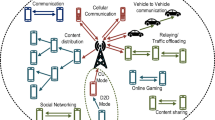Abstract
Device to device communication (D2D) and internet of things are anticipated to rule the globe in the upcoming days. The ever increasing demand for data traffic and throughput pose a unique venture in fifth generation (5G) industry, including limited spectrum and mass device connectivity. The proposed system signifies the specifications putforth by third generation partnership project for D2D communication underlying cellular network. It is highly focused on design and development of its physical layer and link layer . This hybrid 5G non-standalone system is adaptive to operate in different frequency bands. Since the users of D2D and new radio g-NodeB apportion same spectrum, interference would be the resultant. To quell such interference effects and also to maintain high capacity and throughput, here two mechanisms, namely spectrum aggregation and scheduling are emphasized. More over scheduling on component carriers are implemented successfully. At the end, the experimental outcomes prove that the aforementioned two methods results in rapid data transfer rate and eminent capacity with 0.5 ms latency in the controlled path loss environment.








Similar content being viewed by others
References
Ahmad AlAmmouri., A., J. G., & Baccelli, F. (2018). SINR and throughput of dense cellular networks with stretched exponential path loss. IEEE Transactions on Wireless Communications, 17(2), 1147–1160.
Alexander H.-T., & Tamo, A. (2018). BER performance of mm-Wave based systems in rainfall scenarios. In: IEEE XXV International conference on electronics, electrical engineering and computing (INTERCON) (pp. 1–4).
Anupam Kumar B., Nguyen, H., Tran, W., & Saad., et al (2019). A game-theoretic approach for fair coexistence between LTE-U and Wi-Fi systems. IEEE Transactions on Vehicular Technology, 68(1), 442–455.
Christos, G., Tsinos., F. Foukalas., and Khattab, T. (2018). On channel selection for carrier aggregation systems. IEEE Transactions on Communications, 66(2), 808–818.
Hans, J. B., Torbjorn, E., & Gesbert, D. (2008). Channel predictive proportional fair scheduling. IEEE Transactions on Wireless Communications, 7(2), 482–487.
Haya, S., Ahmed, A., & Charles, C. T. (2018). Robust resource allocation with joint Carrier Aggregation in multicarrier cellular networks, IEEE Transactions on Cognitive Communications and Networking, 4(1), 53–65.
Ibraheem, S., Mahamod, I., & Nordin, R. (2013). Downlink spectral efficiency evaluation with carrier aggregation in LTE-Advanced system employing Adaptive Modulation and Coding schemes. IEEE 11th Malaysia International Conference on Communications (MICC), pp. 98–103.
Jeehyeong, K., Nzabanita, A. K., & Cho, S. (2017). An interference mitigation scheme of device-to-device communications for sensor networks underlying LTE-A. Journal on Sensors, 17(5), 1088–1105.
Pimmy G., & KumarJha, R. (2016). Device-to-device communication in cellular networks: A survey. Journal of Network and Computer Applications – Elseiver Journal, 71, 99–117.
Bin, L., Guo, W.., Zhang, H.., Zhao, C.., Li, S., & Nallanathan, A. (2019). Spectrum detection and link quality assessment for heterogeneous shared ƒaccess networks. IEEE Transactions on Vehicular Technology, 68(2), 1431–1445.
Li, R., Hong, P., Xue, K., Zhang, M., & Yang, T. (2020). Energy-efficient resource allocation for high-rate underlay D2D communications with statistical CSI: A one-to-many strategy. IEEE Transactions on Vehicular Technology, 69(4), 4006–4018.
Liang, C., Li, G. Y.., Li, J., & Li, R. (2016). Blind parameter estimation of GFDM signals over frequency-selective fading channels. IEEE Transactions on Communications, 64(3), 1120–1131.
Mahmoud, A. M., & Albreem. (2015). 5G wireless communication systems: vision and challenges. IEEE international conference on computer, communication and control technology (I4CT 2015) (pp. 493–497).
Arash, A., Qing, W., & Mancuso, V. (2014). A survey on device-to-device communication in cellular networks. IEEE Communications Surveys & Tutorials, 16(4), 1801–1819.
Marco, N., Pecorella, M.-G. D. B. T., et al. (2017). Ultra-broadband mobile networks from LTE-Advanced to 5G: Evaluation of massive MIMO and multi-carrier aggregation effectiveness. AEIT International Annual Conference (pp. 1–6).
Mathew, K. S., Theodore, S., & Rappaport (2016). 3D millimeter wave statistical channel model for 5G wireless system design. IEEE Transactions on Microwave Theory and Techniques, 64(7), 2207–2225.
Mohammed Salih., Gismalla, M.., Ibrahim Khider Eltahir. (2015). Interference Reduction Between Device to Device (D2D) Communication Underlying Cellular Networks. International Journal of Scientific & Engineering Research, 6(11), 410 – 414.
Mohsen, M., & Majid, G. (2011). Fair and efficient scheduling in wireless networks with successive interference cancellation. IEEE conference on Wireless Communication and networking (IEEE WCNC 2011 - MAC) (pp. 221–226).
Najib, A., Odhah., Moawad, I., Dessouky., Waleed, E., Al-Hanafy, & Fathi, E. Abd El-Samie. (2012). Low complexity greedy power allocation algorithm for proportional resource allocation in multi-user OFDM systems. Internaltional Journal of Telecommunications and Information Technology (pp. 38–45).
Naveena, A., Priyadharsini., & Tamil Selvi, S. (2019). Effective scheduling policies to optimize radio resources between NR-gNodeB and device to device systems in 5G. Wireless Personal Communications - Springer Journal, 109, 1071–1093.
Panagiotis, D.. Diamantoulakis., Koralia, N. P.,, & Muhaidat, S., et al (2016). Carrier aggregation for cooperative cognitive radio networks. IEEE Transactions on Vehicular Technology, 66(7), 5904–5918.
Tehrani., M. N., Uysal, M. & Yanikomeroglu. (2014). Device to device communication in 5G cellular networks: Challenges, solutions and future directions. IEEE Communication Magazine (pp. 86–92).
Author information
Authors and Affiliations
Corresponding author
Additional information
Publisher's Note
Springer Nature remains neutral with regard to jurisdictional claims in published maps and institutional affiliations.
Rights and permissions
About this article
Cite this article
Priyadharsini, N.A., Tamil Selvi, S. Adaptive Spectrum Aggregation Regimen for Downlink NR-gNodeB and Device to Device Systems in 5G. Wireless Pers Commun 117, 1755–1771 (2021). https://doi.org/10.1007/s11277-020-07944-5
Accepted:
Published:
Issue Date:
DOI: https://doi.org/10.1007/s11277-020-07944-5




